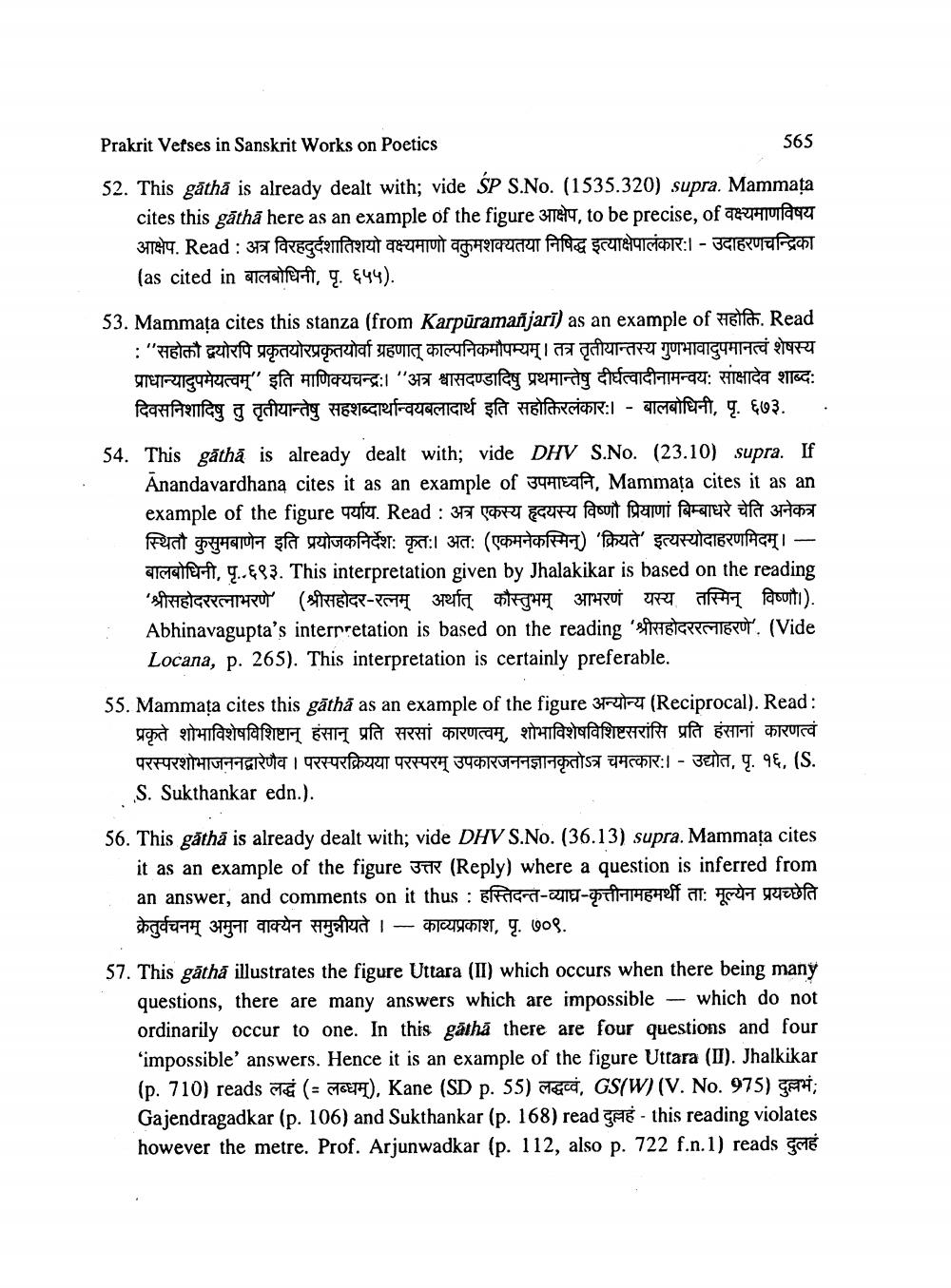________________
Prakrit Vefses in Sanskrit Works on Poetics
565 52. This gatha is already dealt with; vide SP S.No. (1535.320) supra. Mammata
cites this gatha here as an example of the figure आक्षेप, to be precise, of वक्ष्यमाणविषय आक्षेप. Read : अत्र विरहदुर्दशातिशयो वक्ष्यमाणो वकुमशक्यतया निषिद्ध इत्याक्षेपालंकारः। - उदाहरणचन्द्रिका (as cited in बालबोधिनी, पृ. ६५५).
53. Mammața cites this stanza (from Karpūramañjari) as an example of holes. Read
: "सहोतौ द्वयोरपि प्रकृतयोरप्रकृतयोर्वा ग्रहणात् काल्पनिकमौपम्यम्। तत्र तृतीयान्तस्य गुणभावाऽपमानत्वं शेषस्य प्राधान्यादुपमेयत्वम्" इति माणिक्यचन्द्रः। "अत्र श्वासदण्डादिषु प्रथमान्तेषु दीर्घत्वादीनामन्वय: साक्षादेव शाब्द:
दिवसनिशादिषु तु तृतीयान्तेषु सहशब्दार्थान्वयबलादार्थ इति सहोक्तिरलंकारः। - बालबोधिनी, पृ. ६७३. . 54. This gāthā is already dealt with; vide DHV S.No. (23.10) supra. If
Anandavardhana cites it as an example of 34HTET, Mammața cites it as an example of the figure पर्याय. Read : अत्र एकस्य हृदयस्य विष्णौ प्रियाणां बिम्बाधरे चेति अनेकत्र स्थितौ कुसुमबाणेन इति प्रयोजकनिर्देश: कृतः। अत: (एकमनेकस्मिन्) 'क्रियते' इत्यस्योदाहरणमिदम्। - बालबोधिनी, पृ..६९३. This interpretation given by Jhalakikar is based on the reading 'श्रीसहोदररत्नाभरणे' (श्रीसहोदर-रत्नम् अर्थात् कौस्तुभम् आभरणं यस्य तस्मिन् विष्णौ।). Abhinavagupta's interrretation is based on the reading 'श्रीसहोदररत्नाहरणे. (Vide Locana, p. 265). This interpretation is certainly preferable.
55. Mammata cites this gātha as an example of the figure 3Pula (Reciprocal). Read:
प्रकृते शोभाविशेषविशिष्टान् हंसान् प्रति सरसां कारणत्वम्, शोभाविशेषविशिष्टसरांसि प्रति हंसानां कारणत्वं परस्परशोभाजननद्वारेणैव । परस्परक्रियया परस्परम् उपकारजननज्ञानकृतोऽत्र चमत्कारः। - उद्योत, पृ. १६, (S. S. Sukthankar edn.).
56. This gāthā is already dealt with; vide DHV S.No. (36.13) supra. Mammaţa cites
it as an example of the figure JTR (Reply) where a question is inferred from an answer, and comments on it thus : हस्तिदन्त-व्याघ्र-कृत्तीनामहमर्थी ता: मूल्येन प्रयच्छति क्रेतुर्वचनम् अमुना वाक्येन समुन्नीयते । - काव्यप्रकाश, पृ. ७०९.
57. This gātha illustrates the figure Uttara (II) which occurs when there being many
questions, there are many answers which are impossible - which do not ordinarily occur to one. In this gåth, there are four questions and four 'impossible' answers. Hence it is an example of the figure Uttara (II). Jhalkikar (p. 710) reads लद्धं ( लब्धम्), Kane (SD p. 55) लद्धव्वं, GS(W) (V. No. 975) दुल्लभं; Gajendragadkar (p. 106) and Sukthankar (p. 168) read दुल्लहं - this reading violates however the metre. Prof. Arjunwadkar (p. 112, also p. 722 f.n.1) reads दुलहं




